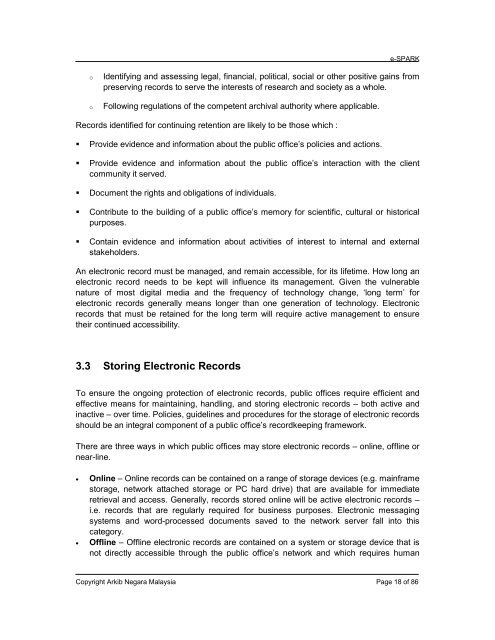Arkib Negara ELECTRONIC RECORDS MANAGEMENT and archive mgmt guideline_eng
Create successful ePaper yourself
Turn your PDF publications into a flip-book with our unique Google optimized e-Paper software.
e-SPARK<br />
o<br />
o<br />
Identifying <strong>and</strong> assessing legal, financial, political, social or other positive gains from<br />
preserving records to serve the interests of research <strong>and</strong> society as a whole.<br />
Following regulations of the competent archival authority where applicable.<br />
Records identified for continuing retention are likely to be those which :<br />
<br />
<br />
<br />
<br />
<br />
Provide evidence <strong>and</strong> information about the public office’s policies <strong>and</strong> actions.<br />
Provide evidence <strong>and</strong> information about the public office’s interaction with the client<br />
community it served.<br />
Document the rights <strong>and</strong> obligations of individuals.<br />
Contribute to the building of a public office’s memory for scientific, cultural or historical<br />
purposes.<br />
Contain evidence <strong>and</strong> information about activities of interest to internal <strong>and</strong> external<br />
stakeholders.<br />
An electronic record must be managed, <strong>and</strong> remain accessible, for its lifetime. How long an<br />
electronic record needs to be kept will influence its management. Given the vulnerable<br />
nature of most digital media <strong>and</strong> the frequency of technology change, ‘long term’ for<br />
electronic records generally means longer than one generation of technology. Electronic<br />
records that must be retained for the long term will require active management to ensure<br />
their continued accessibility.<br />
3.3 Storing Electronic Records<br />
To ensure the ongoing protection of electronic records, public offices require efficient <strong>and</strong><br />
effective means for maintaining, h<strong>and</strong>ling, <strong>and</strong> storing electronic records – both active <strong>and</strong><br />
inactive – over time. Policies, <strong>guideline</strong>s <strong>and</strong> procedures for the storage of electronic records<br />
should be an integral component of a public office’s recordkeeping framework.<br />
There are three ways in which public offices may store electronic records – online, offline or<br />
near-line.<br />
• Online – Online records can be contained on a range of storage devices (e.g. mainframe<br />
storage, network attached storage or PC hard drive) that are available for immediate<br />
retrieval <strong>and</strong> access. Generally, records stored online will be active electronic records –<br />
i.e. records that are regularly required for business purposes. Electronic messaging<br />
systems <strong>and</strong> word-processed documents saved to the network server fall into this<br />
category.<br />
• Offline – Offline electronic records are contained on a system or storage device that is<br />
not directly accessible through the public office’s network <strong>and</strong> which requires human<br />
Copyright <strong>Arkib</strong> <strong>Negara</strong> Malaysia Page 18 of 86


